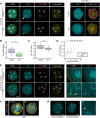Establishment of a relationship between blastomere geometry and YAP localisation during compaction
- PMID: 32928909
- PMCID: PMC7561472
- DOI: 10.1242/dev.189449
Establishment of a relationship between blastomere geometry and YAP localisation during compaction
Abstract
Precise patterning within the three-dimensional context of tissues, organs and embryos implies that cells can sense their relative position. During preimplantation development, outside and inside cells rely on apicobasal polarity and the Hippo pathway to choose their fate. Despite recent findings suggesting that mechanosensing might be central to this process, the relationship between blastomere geometry (i.e. shape and position) and the Hippo pathway effector YAP remains unknown. We used a highly quantitative approach to analyse information on the geometry and YAP localisation of individual blastomeres of mouse and human embryos. We identified the proportion of exposed cell surface area as most closely correlating with the nuclear localisation of YAP. To test this relationship, we developed several hydrogel-based approaches to alter blastomere geometry in cultured embryos. Unbiased clustering analyses of blastomeres from such embryos revealed that this relationship emerged during compaction. Our results therefore pinpoint the time during early embryogenesis when cells acquire the ability to sense changes in geometry and provide a new framework for how cells might integrate signals from different membrane domains to assess their relative position within the embryo.
Keywords: Biocompatible polymers; Compaction; Hippo signalling; Human embryo.
© 2020. Published by The Company of Biologists Ltd.
Conflict of interest statement
Competing interestsThe authors declare no competing or financial interests.
Figures






Similar articles
-
Par-aPKC-dependent and -independent mechanisms cooperatively control cell polarity, Hippo signaling, and cell positioning in 16-cell stage mouse embryos.Dev Growth Differ. 2015 Oct;57(8):544-56. doi: 10.1111/dgd.12235. Epub 2015 Oct 9. Dev Growth Differ. 2015. PMID: 26450797 Free PMC article.
-
Initiation of Hippo signaling is linked to polarity rather than to cell position in the pre-implantation mouse embryo.Development. 2014 Jul;141(14):2813-24. doi: 10.1242/dev.107276. Epub 2014 Jun 19. Development. 2014. PMID: 24948601
-
Live imaging YAP signalling in mouse embryo development.Open Biol. 2022 Jan;12(1):210335. doi: 10.1098/rsob.210335. Epub 2022 Jan 19. Open Biol. 2022. PMID: 35042406 Free PMC article.
-
Retrospective analysis: reproducibility of interblastomere differences of mRNA expression in 2-cell stage mouse embryos is remarkably poor due to combinatorial mechanisms of blastomere diversification.Mol Hum Reprod. 2018 Jul 1;24(7):388-400. doi: 10.1093/molehr/gay021. Mol Hum Reprod. 2018. PMID: 29746690
-
Position- and polarity-dependent Hippo signaling regulates cell fates in preimplantation mouse embryos.Semin Cell Dev Biol. 2015 Dec;47-48:80-7. doi: 10.1016/j.semcdb.2015.05.003. Epub 2015 May 15. Semin Cell Dev Biol. 2015. PMID: 25986053 Review.
Cited by
-
Multiscale analysis of single and double maternal-zygotic Myh9 and Myh10 mutants during mouse preimplantation development.Elife. 2021 Apr 19;10:e68536. doi: 10.7554/eLife.68536. Elife. 2021. PMID: 33871354 Free PMC article.
-
Generative model for the first cell fate bifurcation in mammalian development.bioRxiv [Preprint]. 2025 Feb 25:2025.02.24.639895. doi: 10.1101/2025.02.24.639895. bioRxiv. 2025. Update in: Development. 2025 Aug 05:dev.204717. doi: 10.1242/dev.204717. PMID: 40060535 Free PMC article. Updated. Preprint.
-
Polarization-independent regulation of the subcellular localization of Yes-associated protein 1 during preimplantation development.J Biol Chem. 2025 Apr;301(4):108429. doi: 10.1016/j.jbc.2025.108429. Epub 2025 Mar 19. J Biol Chem. 2025. PMID: 40118454 Free PMC article.
-
Mechanical regulation of chromatin and transcription.Nat Rev Genet. 2022 Oct;23(10):624-643. doi: 10.1038/s41576-022-00493-6. Epub 2022 May 23. Nat Rev Genet. 2022. PMID: 35606569 Review.
-
Geometric, cell cycle and maternal-to-zygotic transition-associated YAP dynamics during preimplantation embryo development.bioRxiv [Preprint]. 2025 Feb 27:2025.02.27.640568. doi: 10.1101/2025.02.27.640568. bioRxiv. 2025. Update in: Dev Biol. 2025 Aug;524:105-115. doi: 10.1016/j.ydbio.2025.05.006. PMID: 40060487 Free PMC article. Updated. Preprint.
References
-
- Couzens A. L., Knight J. D. R., Kean M. J., Teo G., Weiss A., Dunham W. H., Lin Z.-Y., Bagshaw R. D., Sicheri F., Pawson T. et al. (2013). Protein interaction network of the mammalian hippo pathway reveals mechanisms of kinase-phosphatase interactions. Sci. Signal. 6, rs15-rs15 10.1126/scisignal.2004712 - DOI - PubMed
Publication types
MeSH terms
Substances
Grants and funding
LinkOut - more resources
Full Text Sources
Molecular Biology Databases

